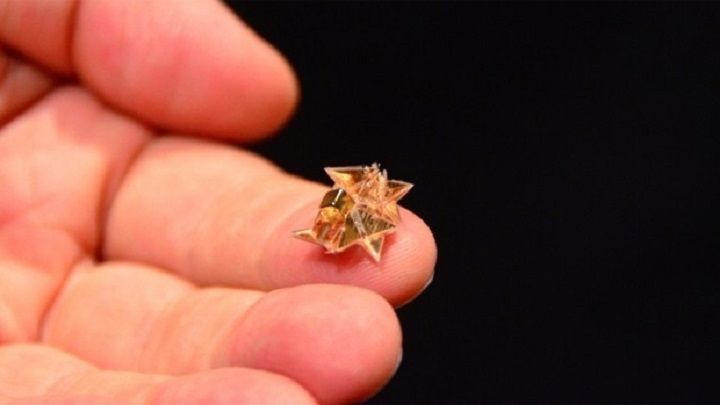
It's what is known as nanomedicine - the use of machines so tiny that they can enter the human bloodstream and address health issues from the inside. With improvements made in miniaturization and nanoassembly over the past few decades, a wide range of applications are being considered and developed - ranging from tiny biosensors and nanoscale materials to actual nanorobots.
And with the creation of their Origami Robot, researchers at MIT's Computer Science and Artificial Intelligence Laboratory (CSAIL) are one step closer to realizing the dream of nanomedicine. The robot was presented last week at the International Conference for Robotics and Automation (ICRA 2015), an annual conference sponsored by the IEEE that covers advances in robotics.
Presenting to a packed house, the CSAIL team demonstrated their design for an untethered miniature origami robot that self-folds, walks, swims, and dissolves. This process begins with a two-dimensional sheet of PVC plastic or paper with magnets on it which, when exposed to a heat source, folds itself into its robot configuration within a matter of seconds.
The assembled robot is then guided around using magnets to perform various tasks. For the sake of their demonstration, the CSAIL team showed the robot moving around on an open surface, across water, and then had it push tiny pink blocks towards tiny pink targets. It all ended with the robot being dunked into a tank of acetone, where it completely dissolved.
The research team, which is led by Dr. Shuhei Miyashita, has been working on the robot since 2012. The robots they presented at ICRA 2015 was the latest iteration, and featured a slew of recent innovations and breakthroughs.

Diagram showing the CSAIL Origami Robot, its components and functions, all to scale. Credit: csail.mit.edu
For starters, it demonstrated a working "4D" concept, where components that are created using a 3D printer are able to assemble themselves after being exposed to light or heat. It also demonstrated how such a robot could work without tethers or connections, leaving it free to perform tasks with greater autonomy.
But what was arguably the most impressive aspect was their robot's capability of disassembling itself once it was finished. This is an especially important function when it comes to nanomachines, which need to be disposed of once they are no longer in use. Knowing that their are options other than surgery, or the accumulation of nanomachines in the bloodstream, is encouraging news indeed!
In a research paper that accompanied the robot demonstration at ICRA 2015, the team listed some of the applications that such a robots could have. For starters, they claim that this miniature robotic device could promise a range of medical applications for use "in vivo" (i.e. on human subjects), assuming it could be made to dissolve within the human body.
"The dissolving process of the water-degradable model was tested under the assumption that future advancements would make the model biodegradable," the paper reads. "To construct a biodegradable model for clinical use, the contraction layer (PVC film) and the adhesive layer need to be replaced with biodegradable counterparts."
The CSAIL team is confident about meeting all of these challenges, and future iterations of their Origami Robot are likely to be able to dissolve on their own without any human intervention. And with other refinements (and possibly even further miniaturization) it would not be surprising to see such robots entering clinical trials in the coming years.
Just imagine, tiny machines cleansing our arteries of film and cholesterol, administering drugs directly to tumors and infected tissues, or performing microscopic examinations. The age of nanomedecine beckons!
Got ideas for nanotechnology? Then be sure to check out the Self-Assembling Robot Challenge, or head on over to the Launch your Challenge page to create your own!
Top Image Credit: IEEE Spectrum/Shuhei Miyashita








